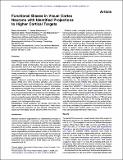| dc.contributor.author | Jarosiewicz, Beata | |
| dc.contributor.author | Schummers, James | |
| dc.contributor.author | Malik, Wasim Qamar | |
| dc.contributor.author | Brown, Emery Neal | |
| dc.contributor.author | Sur, Mriganka | |
| dc.date.accessioned | 2014-11-19T13:40:50Z | |
| dc.date.available | 2014-11-19T13:40:50Z | |
| dc.date.issued | 2012-02 | |
| dc.date.submitted | 2012-01 | |
| dc.identifier.issn | 09609822 | |
| dc.identifier.issn | 1879-0445 | |
| dc.identifier.uri | http://hdl.handle.net/1721.1/91607 | |
| dc.description.abstract | Background:
Visual perception involves information flow from lower- to higher-order cortical areas, which are known to process different kinds of information. How does this functional specialization arise? As a step toward addressing this question, we combined fluorescent retrograde tracing with in vivo two-photon calcium imaging to simultaneously compare the tuning properties of neighboring neurons in areas 17 and 18 of ferret visual cortex that have different higher cortical projection targets.
Results:
Neurons projecting to the posterior suprasylvian sulcus (PSS) were more direction selective and preferred shorter stimuli, higher spatial frequencies, and higher temporal frequencies than neurons projecting to area 21, anticipating key differences between the functional properties of the target areas themselves. These differences could not be explained by a correspondence between anatomical and functional clustering within early visual cortex, and the largest differences were in properties generated within early visual cortex (direction selectivity and length preference) rather than in properties present in its retinogeniculate inputs.
Conclusions:
These projection cell groups, and hence the higher-order visual areas to which they project, likely obtain their functional properties not from biased retinogeniculate inputs but from highly specific circuitry within the cortex. | en_US |
| dc.description.sponsorship | Ruth L. Kirschstein National Research Service Award (5F32NS054390) | en_US |
| dc.description.sponsorship | National Institutes of Health (U.S.) (Grant EY018648) | en_US |
| dc.description.sponsorship | National Institutes of Health (U.S.) (Grant EY07023) | en_US |
| dc.description.sponsorship | National Institutes of Health (U.S.) (Grant DP1 OD003646) | en_US |
| dc.description.sponsorship | National Institutes of Health (U.S.) (Grant EB006385) | en_US |
| dc.language.iso | en_US | |
| dc.publisher | Elsevier | en_US |
| dc.relation.isversionof | http://dx.doi.org/10.1016/j.cub.2012.01.011 | en_US |
| dc.rights | Article is available under a Creative Commons license; see publisher’s site for details. | en_US |
| dc.source | Elsevier | en_US |
| dc.title | Functional Biases in Visual Cortex Neurons with Identified Projections to Higher Cortical Targets | en_US |
| dc.type | Article | en_US |
| dc.identifier.citation | Jarosiewicz, Beata, James Schummers, Wasim Q. Malik, Emery N. Brown, and Mriganka Sur. “Functional Biases in Visual Cortex Neurons with Identified Projections to Higher Cortical Targets.” Current Biology 22, no. 4 (February 2012): 269–277. © 2012 Elsevier Ltd. | en_US |
| dc.contributor.department | Harvard University--MIT Division of Health Sciences and Technology | en_US |
| dc.contributor.department | Massachusetts Institute of Technology. Department of Brain and Cognitive Sciences | en_US |
| dc.contributor.department | Picower Institute for Learning and Memory | en_US |
| dc.contributor.mitauthor | Jarosiewicz, Beata | en_US |
| dc.contributor.mitauthor | Schummers, James | en_US |
| dc.contributor.mitauthor | Malik, Wasim Qamar | en_US |
| dc.contributor.mitauthor | Brown, Emery N. | en_US |
| dc.contributor.mitauthor | Sur, Mriganka | en_US |
| dc.relation.journal | Current Biology | en_US |
| dc.eprint.version | Final published version | en_US |
| dc.type.uri | http://purl.org/eprint/type/JournalArticle | en_US |
| eprint.status | http://purl.org/eprint/status/PeerReviewed | en_US |
| dspace.orderedauthors | Jarosiewicz, Beata; Schummers, James; Malik, Wasim Q.; Brown, Emery N.; Sur, Mriganka | en_US |
| dc.identifier.orcid | https://orcid.org/0000-0003-2442-5671 | |
| dc.identifier.orcid | https://orcid.org/0000-0003-2668-7819 | |
| dc.identifier.orcid | https://orcid.org/0000-0002-7260-7560 | |
| dspace.mitauthor.error | true | |
| mit.license | PUBLISHER_POLICY | en_US |
| mit.metadata.status | Complete | |
